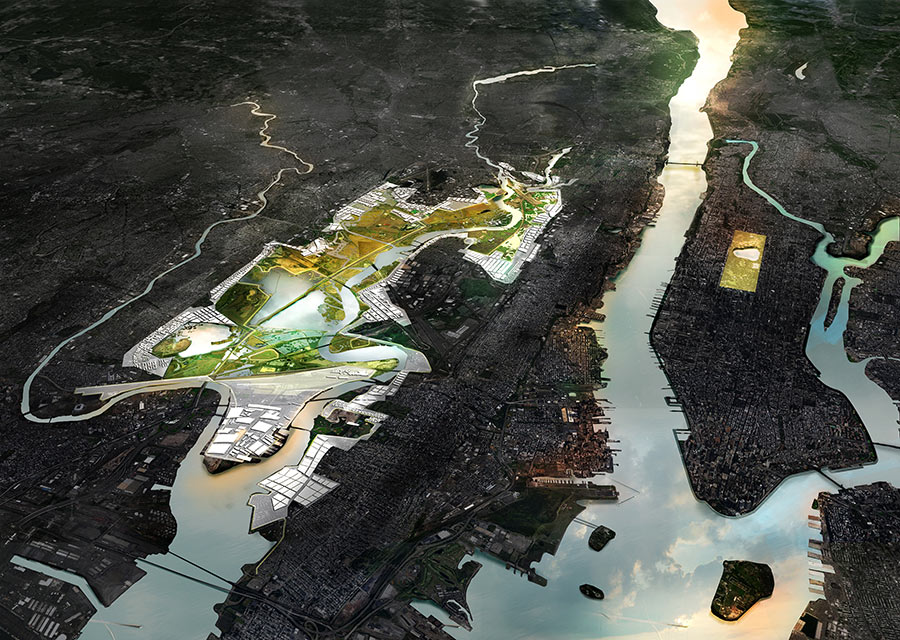Featured Stories | June 15, 2014
MIT’s Plan to Save New Jersey from the Next Hurricane Wins the HUD Competition
An MIT team has won the Rebuild by Design competition with their innovative plan to protect New Jersey and Metropolitan New York coastlines from the next Hurricane Sandy.
By Genevieve Wanucha
Hurricane Sandy of 2012 brutally exposed the vulnerabilities of the New Jersey and Metropolitan New York coastlines to storm surges from the Atlantic Ocean, prompting citizens and governmental officials to take action. The US Department of Housing and Urban Development (HUD) and the Presidential Hurricane Sandy Rebuilding Task Force responded to the problem by initiating Rebuild by Design, a large competition funded by the Rockefeller Foundation meant to create innovative solutions to protect coastal US cities in future storms. A team from MIT was selected as one of the 10 finalists out of 40 entries, and it has now won the competition along with several others.
The MIT team–a merger of urban designers, architects, environmental engineers, and European design firms Zus and Urbanist–proposed the idea to create a multifunctional climate-resilient urban landscape. They now have the $150 million prize in a Sandy-related Community Development Block Grant to implement the first phase. The plan is to transform New Jersey’s endangered low-lying wetlands into a large nature reserve and park surrounded by an intricate system of berms and pipes for flood protection. A seamless integration of the park with urban infrastructure and transportation systems is meant to stimulate economic growth and community development at the same time.

At the 6th annual MIT Sustainability Summit earlier in May, Kobi Ruthenberg, a design associate at MIT Center for Advanced Urbanism (CAU) in the Department of Urban Studies and Planning (DUSP) presented the team’s plan: The New Meadowlands.
This Rebuild by Design entry grew out of a project to locate the most critically at-risk zones in New Jersey and the New York Metropolitan area. Their preliminary analysis found that 2.5 million inhabitants live in flood zones. About 66% of most socially vulnerable people and 80% of regional fuel storage are located in flood zones. They then used an extensive regional mapping approach to find the spots at which multiple risks and vulnerabilities intersect. “In other words, these are the areas where federal dollars can be most effective,” said Ruthenberg. Their map showed the best investment to be the New Jersey Meadowlands, a low lying river delta ecosystem of fresh and saltwater wetlands that are polluted by surrounding industrial and commercial development.

THE MEADOWLANDS
First, the project aims to transform the marshland into a accessible nature reserve called Meadow Park, which extends the efforts of the New Jersey Meadowlands Commission to protect the biodiversity of the coast’s marine life. Surrounding the park is a new system of berms, or raised barriers, and drainage pumps that fortifies the entire inland district against storm ocean surges, collect rainfall to reduce flooding, and divert storm water from the sewage systems.

The nature-city interface is Meadow Band, a continuous “civic amenity” which runs on top of outer perimeter berms of Meadow Park, which consists of a street, a train line and a bike path with a variety of access points to Meadow Park. To use land more effectively and encourage smaller footprints in the wider Meadowlands district, The MIT proposes to shift from suburban sprawl to urban zoning by constructing multiple-story buildings.
The idea behind the New Meadowlands project emerged through many workshops with stakeholders in community and the New Jersey Meadowland Commission (NJMC). “We attempted to achieve a balance between competing environmental, economic, social interests in a way that maximizes the benefit to all,” Ruthenberg explained.
The cooperation with the community and local government is what gave MIT CAU a chance at winning the competition, according to Australian architect and summit speaker Helen Lochhead, a Lincoln/Loeb Fellow at the Harvard Graduate School of Design who used Rebuild by Design as a case study of environmental design projects. “It enables the capacity of holistic development by bringing a lot of different players together under one institution. The greatest value is created when design addresses not only flood risk, but also environmental degradation and social vulnerability, as this project does.”
MIT team members come from MIT’s DUSP, Department of Architecture, and Department Civil and Environmental Engineering, and include Alan Berger, Eran Ben-Joseph, Case Brown, Michael Foster, Kate Goldstein, Alexander D’Hooghe, Alexis Howland, Miho Mazereeuw, Heidi Nepf, Jonah Rogoff, Alicia Rouault, Yaccov Ruthenberg, Lawrence Vale, James Wescoat, Sarah Williams, Wenfei Xu, Meejin Yoon, and Kobi Ruthenberg.
Video: New Meadowlands from Rebuild by Design on Vimeo





